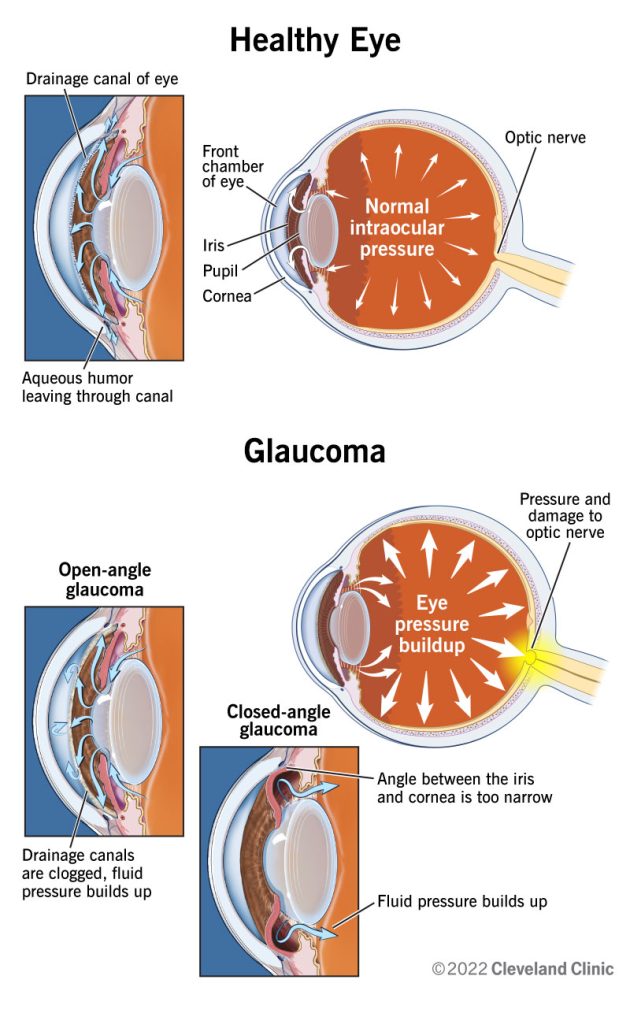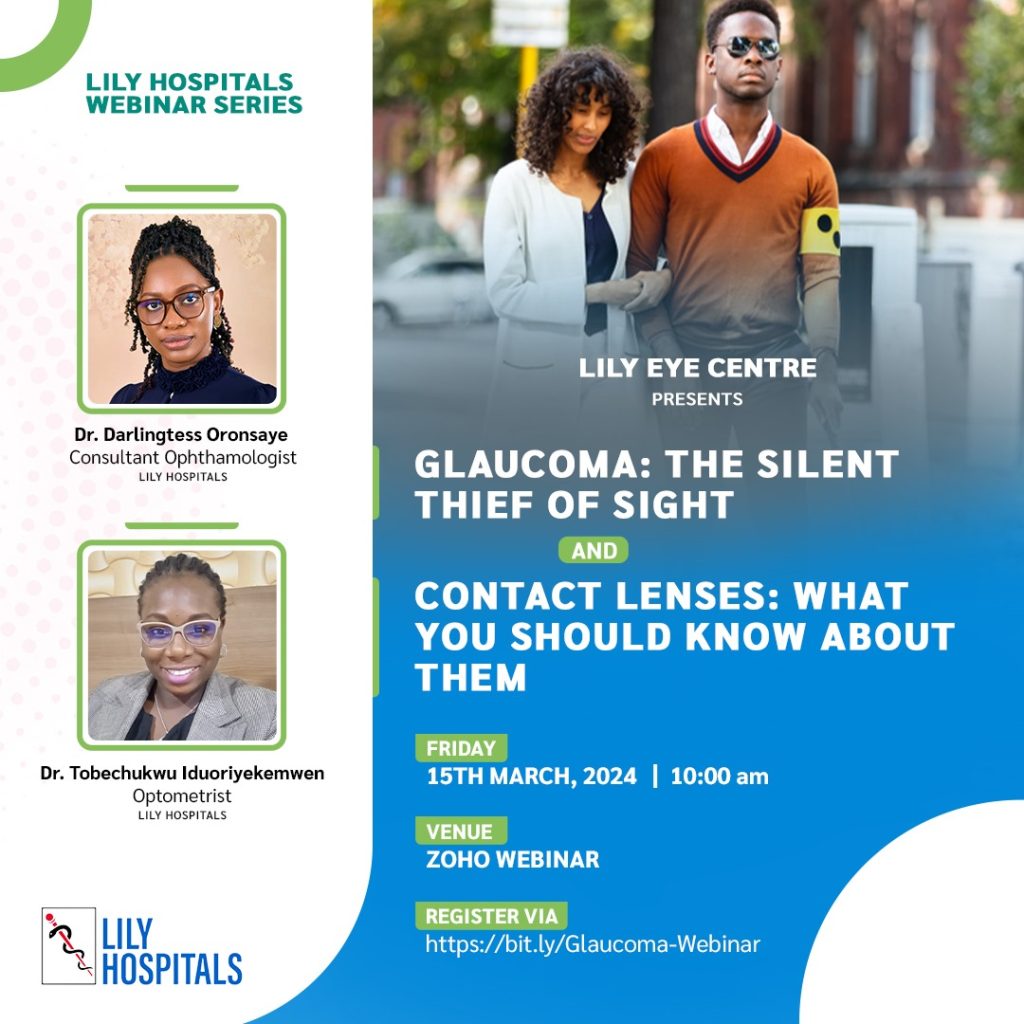
What Is Glaucoma
Glaucoma is a group of progressive eye diseases that damage the nerve that connects the eye to the brain and helps us see (optic nerve).
It is the leading cause of irreversible blindness worldwide. This damage usually occurs when the pressure in the eye is elevated or the nerve is compromised even at normal eye pressure. This pressure is known as intraocular pressure (IOP), commonly referred to as eye pressure. However, it’s important to note that while some individuals may maintain normal eye pressure, they can still develop glaucoma.
If left untreated or improperly managed, glaucoma can result in permanent and irreversible vision loss, potentially leading to blindness.

Image credit: Cleverland Clinic
How Common is Glaucoma?
Glaucoma which is the leading cause of blindness after cataracts globally, is very common and said to be present in over three million people (children and adults) in Nigeria. Of these affected populations, about a million have visual impairment or are blind already.
Types of Glaucoma
There are several types of Glaucoma including
Open-angle glaucoma:
This is the most common form of glaucoma and often develops slowly over time. This condition occurs when resistance develops in the drainage canals of your eye. Although your drainage canals seem open and operational, fluid accumulates over time, resulting in increased pressure on your optic nerve. Over time, this elevated pressure can damage the optic nerve, resulting in vision loss.
Angle-closure glaucoma:
Unlike open-angle glaucoma, angle-closure glaucoma occurs when the drainage angle between the iris and cornea becomes blocked or closes off completely. This closure can cause a sudden increase in IOP, leading to symptoms such as severe eye pain, headaches, blurred vision, and nausea. Angle-closure glaucoma requires immediate medical attention to prevent permanent vision loss.
Normal-tension glaucoma:
In this type of glaucoma, damage to the optic nerve occurs despite normal IOP levels. The exact cause of normal-tension glaucoma is not fully understood, but factors such as reduced blood flow to the optic nerve and genetic predisposition may play a role. Monitoring and managing risk factors such as high blood pressure and low blood pressure are crucial in preventing further vision loss.
Secondary glaucoma:
Secondary glaucoma develops as a result of other eye conditions or factors, such as eye trauma, inflammation, tumours, or certain medications. Treatment typically involves addressing the underlying cause, such as surgery to remove a tumour or discontinuing medication known to increase IOP.
Congenital glaucoma:
Congenital glaucoma is present at birth and is typically caused by abnormalities in the eye’s drainage system. Symptoms may include excessive tearing, light sensitivity, and enlarged eyes. Early diagnosis and treatment, often involving surgery, are essential to prevent vision loss and preserve visual function.
Pigmentary glaucoma:
Pigmentary glaucoma occurs when pigment granules from the iris accumulate and block the drainage angle, leading to increased IOP. This type of glaucoma is more common in younger adults and may be associated with activities that cause the iris to rub against other eye structures, such as exercise.
Symptoms of Glaucoma
Glaucoma does not usually show any symptoms in the early phase and unfortunately, progression usually continues with the patient unaware of it. Most patients are diagnosed by coincidence.
However, in advanced states, symptoms may include
- Poor peripheral vision
- Blurred vision and bumping into objects
- Difficulty in driving at night
- Frequent changes in reading glasses and
- Severe eye pain
- Nausea or vomiting
- Redness in the eye
- Tunnel vision in advanced stages
- Headaches
- Eye sensitivity to light
- Even total blindness may be the first symptom in some people.
In cases like open-angle glaucoma, symptoms may not be noticeable, underscoring the importance of regular eye exams for early detection.
Since glaucoma damage is irreversible, timely intervention is crucial to prevent blindness.
Causes of Glaucoma
The major cause of Glaucoma is still unknown but it is largely found to be hereditary that is, it runs in the family.
However, a few Secondary causes have been linked with glaucoma and these include;
- Chronic of steroids
- Pseudo exfoliation syndrome
- Eye trauma (angle recession glaucoma)
- Abnormal congenital conditions,
- Uveitis (inflammation of the uvea tissues)
- Aphakia, and other lens abnormalities amongst others
Who are at risk of Glaucoma
Glaucoma can happen to anyone, but it’s more common as people get older. Black people have a higher chance of getting glaucoma and may get it at a younger age. If you have diabetes, you’re also more likely to get glaucoma. Other things that can increase your risk include:
- You are more than forty years of age (risk increases X2) although glaucoma can still occur in newborns, infants, teenagers as well as young adults
- You are short-slighted (risk increases x2.5)
- History of hypertension or diabetes or both
- You have a positive family history of glaucoma or worse still a family history of glaucoma blindness (risk further increases x3)
- You have been told to be a glaucoma suspect (risk increases much more X4)
What Am I at Risk of Glaucoma, What Should I Do?
There is no reason to panic, vision loss can be avoided if you respect a simple rule;
Regular eye examination at least once in six months by the Ophthalmologist (a specialist eye surgeon) who may carry out the following test:
- Measurement of intraocular pressure (IOP) (average normal pressure is between 10 and 21mmHg)
- Optic nerve assessment with the ophthalmoscope but the most accurate method is by carrying out optical Coherent Tomography scanning of the optic nerve (OCT test) as this shows the extent of optic nerve and retinal fibre damage.
- Fundus photography (to take a picture of the optic nerve)
- Central Visual field analysis (CVF) which would evaluate your peripheral vision and the extent of damage
- Gonioscopy test to assess whether the eye fluid drainage pathway is open, narrow or closed
- Pachymetry test (CCT) (to assess the corneal thickness) which may affect eye pressure.
Management and Treatment of Glaucoma
Management and treatment of glaucoma aim to slow down or stop the progression of the disease and prevent further damage to the optic nerve. The primary goal is to lower intraocular pressure (IOP), as high pressure is a major risk factor for glaucoma progression.
Treatment options include
- Prescription eye drops
- Oral medications
- Laser therapy, and surgical procedures.
Eye drops are often the first line of treatment and work by either reducing the production of aqueous humour (the fluid inside the eye) or increasing its drainage.
Oral medications may be prescribed if eye drops are ineffective or not well tolerated.
Laser therapy, such as selective laser trabeculoplasty (SLT) or laser peripheral iridotomy (LPI), can help improve drainage of fluid from the eye. In advanced cases or when other treatments are ineffective, surgical procedures like trabeculectomy or implantation of drainage devices may be necessary to lower IOP.
Regular monitoring and follow-up visits with an ophthalmologist are essential to assess the effectiveness of treatment and adjust as needed to maintain optimal eye health.
These treatment methods do not cure glaucoma but can prevent blindness from glaucoma.
Conclusion
Glaucoma is a serious eye condition that can harm your vision without you even noticing. The key is to catch it early through regular eye check-ups. By staying informed, getting your eyes checked regularly, and seeking treatment when needed, you can protect your vision and overall eye health.
Together, let’s work towards preventing vision loss from glaucoma and keeping our eyes healthy for the long term.
For those in Warri or Benin, you can visit Lily Eye Centre at both locations for a comprehensive eye check and treatment of any Glaucoma related disease. All Glaucoma screening tests and treatment facilities are available at our eye centre.
At Lily Hospitals Eye Centre, We bring a vision of excellence to every patient, offering cutting-edge technology and a team of skilled eye care specialists. Your sight deserves the best, and we are here to deliver it!
What We Offer:
–
▶️ Advanced Eye Diagnostics
▶️ Expert Ophthalmologists
▶️ Personalized Eye Treatments
▶️ State-of-the-Art Surgical Procedures
▶️ Comprehensive Eye Care Solutions
Our Services
–
▶️ Phacoemulsification Cataract Surgery (Laser Cataract Surgery)
▶️ Laser Glaucoma surgery
▶️ Optical Coherent Tomography Scanning
▶️ Treatment of Diabetic Eye Diseases
▶️ Retina Clinic
▶️ Optical services ( Glasses, Contact Lenses, Low Vision Services for Advance Glaucoma, Retinitis Pigmentosa & ARMD )
Visit us today at our Warri and Benin Centre for your Comprehensive Eye Care!
Warri
–
6 Brisibe Street, Off Etuwewe, Warri, Delta State
Phone
–
08070365796
Benin Address
–
3, Afe Close, Off Ikpokpan Road, Benin-City
16A Edo-Osagie Street GRA, Benin City Edo State
7 Boundary Road, GRA, Benin City, Edo State
Phone
–
09062835341
Email
–
eyecentre@lilyhospitals.net
WhatsApp
–
+234 916 834 1910



